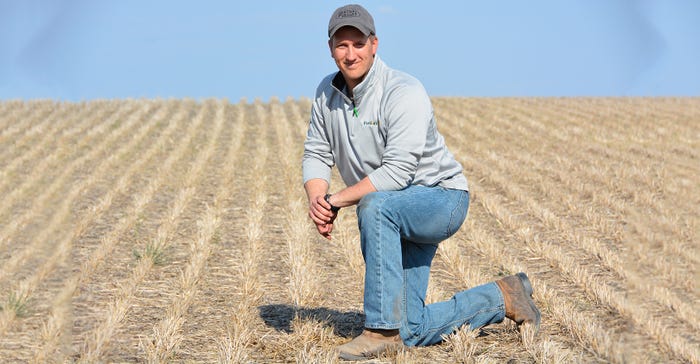June 27, 2017

Tim Brakke and Scott Huso are transitioning more of their northeast North Dakota Ridgeline Farm to no-till. (see “North country no-till”) They have a unique way of converting fields to no-till.
They don’t plant soybeans into corn or wheat stubble the first year, as is often done because soybeans tolerate high levels of crop residue on the soil surface
They start with corn — which really doesn’t like residue.
And they don’t just give no-till a one-year try to see if it will work on a field. Instead, they make a six-year commitment.
Here’s how they go about it:
• In the fall they prepare a wheat, pinto bean or soybean field for corn by chisel plowing, field cultivating, applying fertilizer and incorporating fertilizer. After that fall, they won’t do any major tillage on that field again — ever.
• They plant corn into the tilled-black field with a Case IH 1250 double-disk planter. Corn will do well because seedlings grow quickly on the bare soil created by tillage. Corn also has deep roots, which can break up some of the compaction caused by tillage.
• Following corn the next year, they seed soybeans. They use a John Deere 1890 single-disk drill and seed directly into the standing cornstalks.
• The year after soybeans, they seed wheat.
• After wheat, they rotate to soybeans or pinto beans. They don’t do tillage in the fall. Soybeans leave very little residue on the soil surface. Pinto beans leave almost no residue.
• The next year, they plant corn again and start the rotation over.
Strip tillage, cover crops
Brakke and Huso bought a strip-tillage machine last year and are experimenting with it to set up fields for row crops. Their aim is to get fertilizer placed below the row and still have the benefits of no-till between the rows.
They also are experimenting with cover crops. They planted cover crops on 300 acres last year and 900 acres this year. They are trying to accomplish three things with cover crops:
• have living roots in the soil longer to help feed soil microbes
• break up any compaction in the top 10 inches of the soil profile
• reduce the amount of wheat residue that remains on the soil surface in the spring
Too much wheat residue is currently their biggest challenge with no-till. They have so much wheat residue on the soil surface each spring that hair pinning occurs at a high rate when trying to plant soybeans into damp wheat stubble. They sometimes have to wait for the dew to evaporate from the residue before they can start planting. They added trash whippers to one of their drills to clear residue from the rows, which has helped, but it is not enough alone.
Cover crops may help reduce residue levels because they increase the number of weeks in the fall and the following spring that live roots are in the soil. That increases the amount of food available for soil microbes to eat. With more food available, the soil microbe population grows. Soil microbes also eat residue on the soil surface. The more microbes there are, the more residue is consumed.
“It doesn’t seem logical — add more residue in the form of cover crops to reduce residue — but some no-tillers say that the residue just seems to melt away when they add cover crops,” Huso says.
An increase in the biological activity and faster cycling of residue may make it possible to cut back on the amount of fertilizer they apply without reducing yield potential.
“We think we can get more nutrients from the soil, which would save us some money,” Huso says.
Tillage in no-till
Huso and Brakke aren’t no-till purists, though. They will use shallow vertical tillage if they need to dry out all or parts of fields to get them planted on time. Huso calls it “rescue tillage.” They have been using Salford vertical-tillage implements. They do as little “Salfording” as possible because even shallow tillage compacts the soil. Huso took a penetrometer out in field last year and compared vertically tilled and no-tilled areas. “I could feel the difference,” he says.
Long-term benefits
No-till’s long-term benefits at Ridgeline Farm are clear. There are “big time” differences in soil structure, compaction, erosion, water infiltration rates and water-holding capacity between no-till and conventional-till fields, Huso says.
After a 1-inch rain they can get a sprayer back in a no-till field a day or two sooner than they can a minimum-till field.
If the weather turns dry and hot in mid or late summer, their no-tilled fields will usually yield more than their conventional-tilled fields.
But to get to the long-term benefits, no-till has to be profitable in the short term, Huso says. They have to be able to plant on time, spend the same or less on inputs as with conventional tillage and produce yields equal to or better than conventional tillage.
“We’ll keep converting more acres to no-till until we don’t see that it is more profitable,” Huso says, “and we will keep trying to figure out to how to make no-till work even better.”
You May Also Like




